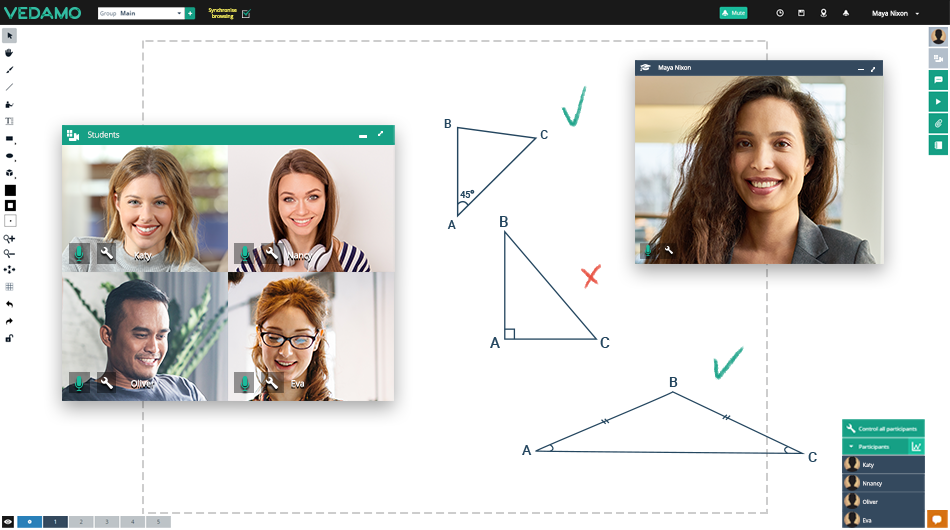Online learners need a sense of community and positive learning experience. The technology cannot guarantee these. Tutors need to implement two simple methods: making reflection of the lesson and giving meaningful feedback to the learners. Reflection And Feedback In Online Teaching Platforms.
Research on asynchronous virtual learning environment shows the prevailing focus on cognitive processes. Seeking to build critical thinking skills, argumentation or knowledge, they isolate the purely human aspect. They exclude learners’ needs of affiliation, support and affirmation[1]. This inevitably reflects on the learning process because one of the most important conditions for its effective functioning (both in a virtual and traditional environment) is the interaction between the participants. The synchronous learning systems, like VEDAMO virtual classroom, overcome these limitations by providing a set of features for implementation of collaborative learning. But the features themselves cannot guarantee the realization of a meaningful learning experience. This depends mostly on their operationalization by the tutors.
“One of the most important conditions for its effective learning process (both in a virtual and traditional environment) is the interaction between the participants.”

The psychological and social aspects are what makes the system an interactive space for learning. In order to enhance these aspects, whatever methods you opt to use at the end of the lesson you should always allot time for reflection and feedback on the part of the participants.
Reflection in online teaching platforms
“Participants think over and formulate inside-out the new knowledge and skills application through their own experience”
Reflection in contemporary education is presented as a convenient form of thinking aloud. In its basis there is a system of elementary questions connected with the main one: “What did we do today?”, “How did we do it?”, “What steps did we make and why?”, “What did we do well?”, “What could we have done better?” or “What can we do better next time?”. This mechanism of asking questions enables the students to “rewind the lesson tape” back-to-forth by pausing at key points and consider them again.

If students have been working into small groups, it is better for the initial reflection to take place within the groups by means of sharing their experiences and impressions from what they have learned. In this way participants think over and formulate inside-out the new knowledge and skills application through their own experience and appreciate their implications for the learners’ personal development. If questions tend to extract the learner out of the context he or she is already used to, this method fosters the transformation process and knowledge transfer from one area into another, whereas in this way the foundations for the acquisition of learning competences are laid.
Reflection contributes to the sense of community and critical thinking skills development.
Feedback in online teaching platforms
“Creating a positive-feedback atmosphere in the group depends mostly on the way the tutor guides the overall group interaction.”
Feedback in online sessions is an essential part both at the end and during the course of the lesson. Participants should receive feedback not only by the tutor but also from their peers. Creating a positive-feedback atmosphere in the group depends mostly on the way the tutor guides the overall group interaction. When providing feedback “the sandwich technique” can be employed, i.e. you start with the positive aspects of the participants’ work and follow up with comments and recommendations for improvement and finish with a positive conclusion. The tutor’s job is not only to follow such a model, but also to build habits in their students for sticking to the positive and constructive tone.
Feedback provision at the end of the session or at the end of the study course may be organised in different ways. For example, you can apply the method of the three-step interview (described above) but in a suitable aspect (e.g. to summarise the material learned in a given lesson). You can encourage the learners while working in small groups to share personal experiences and express opinions concerning the study content. By adhering to this logic you can obtain very good material for omissions and partially understood points as well as about the acquisition level of the study content of the lesson that has just been carried out.

At the end of the lesson as well as at the end of the entire course you can prepare questions in the form of a short questionnaire. The questions must be of an open type, allowing for short answers. (For example: “What did you like about the theatrical performance we did? What didn’t you like? How did you feel in your role? What would you improve?” etc). The-end-of-the-course questionnaire must be more detailed in writing, with mixed questions (both closed and open-ended). In the final questionnaire there must be questions about the electronic resources that were used, the methods that were applied, and interactions with the other participants, technical problems and suggestions for their improvement. From the participants’ answers you can draw conclusions about their feelings, what they liked and did not like about the lesson / course as well as the suggestions they have for its improvement. Such materials allow you to regulate and restructure the building of the virtual lesson / course, to improve, add or change some of its elements according to the participants’ feedback. All of this is a basis for additional personalisation of the study process in accordance with the needs of the group and each participant in it.
